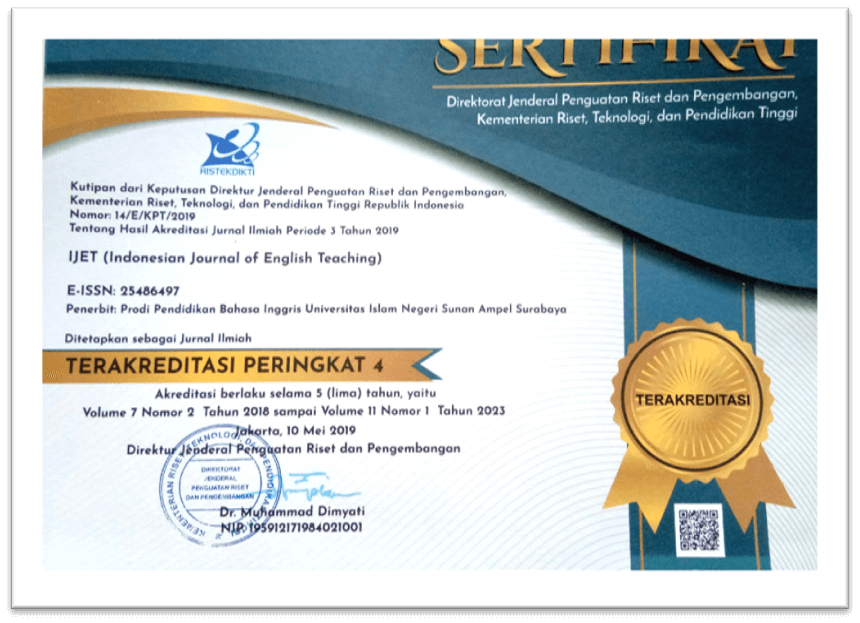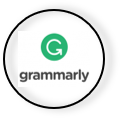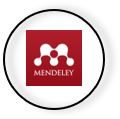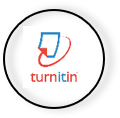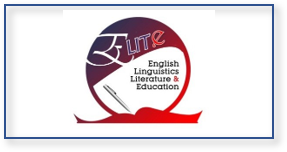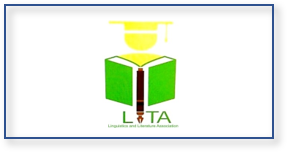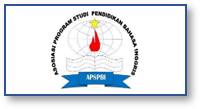The use of authentic material in English classroom teaching: Indonesian New Curriculum
DOI:
https://doi.org/10.15642/ijet2.2023.12.1.94-103Keywords:
Authentic Materials Selection, Curriculum, Integrated Curriculum, Evaluation Curriculum, Curriculum in School.Abstract
The Indonesian current curriculum is derived as operational curriculum for school initiator (KOSP). In language learning, the KOSP focuses on the competences to use the language with six basic skills: listening, reading, speaking and writing, with addition Watching and presenting. “watching and presenting” skills is to accommodate the receptive skill from the video and productive skill through media content such as YouTube, Instagram, Tik Tok etc. The KOSP uses genre-based approach in language teaching that emphasizes on the contextual applicable use of the language. with four main activities: Building knowledge of the text, Modelling of the text, Joint construction of the text and Independent construction of the text. In addition, this paper explores about the use of authentic material and its advantages in language learning classroom. Furthermore, the paper presented some example about the use of authentic material in implementing KOSP specifically for basic English in Junior and senior high school. The first authentic material is students’ photograph to teach recount text where the students tell about the photograph either in written and oral. The second authentic material is students’ realia to teach descriptive text.
Downloads
References
AbdulHussein, F. R. (2014). Investigating EFL College Teachers’ and Learners’ Attitudes toward Using Authentic Reading Materials in Misan. Procedia - Social and Behavioral Sciences, 136, 330–343. https://doi.org/10.1016/j.sbspro.2014.05.338
Agustien, H. (2020). IMPLEMENTING A TEXT-BASED APPROACH IN ENGLISH LANGUAGE TEACHING. Malang: TEFLIN Publication Division in collaboration with Bintang Sejahtera Press.
Beresova, J. (2015). Authentic Materials – Enhancing Language Acquisition and Cultural Awareness. Procedia - Social and Behavioral Sciences, 192, 195–204. https://doi.org/10.1016/j.sbspro.2015.06.028
Cahya, G. H. (2019). Nadiem’s reforms, up to teachers now. Retrieved January 25, 2022, from https://www.thejakartapost.com/news/2019/12/16/nadiems-reforms-teachers-now.html
Chaisiri, T. (2010). Implementing a Genre Pedagogy to the Teaching of Writing in a University Context in Thailand. Language Education in Asia, 1(1), 181–199. https://doi.org/10.5746/leia/10/v1/a16/chaisiri
Djonov, E., Tseng, C. I., & Lim, F. V. (2021). Children’s experiences with a transmedia narrative: Insights for promoting critical multimodal literacy in the digital age. Discourse, Context and Media, 43, 100493. https://doi.org/10.1016/j.dcm.2021.100493
Education, E., & Program, S. (2016). HOW TO TEACH WRITING IN LITERATURE CLASS THROUGH GENRE-BASED APPROACH, 359–384.
Ekşi, G., & Yakışık, B. Y. (2015). An Investigation of Prospective English Language Teachers’ Multimodal Literacy. Procedia - Social and Behavioral Sciences, 199, 464–471. https://doi.org/10.1016/j.sbspro.2015.07.533
Greenstein, L. (2012). Assessing 21st Century Skills: A guide to evaluating mastery and authentic learning. California: Corwin.
Harahap, J., & Rambe, S. (2019). Improving Students’ Writing Ability By Using Genre Based Approach. TAZKIR: Jurnal Penelitian Ilmu-Ilmu Sosial Dan Keislaman, 5(1), 123–138. https://doi.org/10.24952/tazkir.v5i1.1856
Haryanti, H., & Sari, F. (2019). the Use of Genre-Based Approach To Improve Writing Skill in Narrative Text At the Eleventh Grade Students of Sma Ethika Palembang. English Community Journal, 3(1), 280. https://doi.org/10.32502/ecj.v3i1.1693
Hyland, K. (2003). Genre-based pedagogies: A social response to process. Journal of Second Language Writing, 12(1), 17–29. https://doi.org/10.1016/S1060-3743(02)00124-8
Irawansyah, I. (2016). Genre Based Approach: A Way to Enhance Studentsâ Writing Ability. English Education: Jurnal Tadris Bahasa Inggris IAIN Raden Intan, 9(1), 74–88. https://doi.org/10.24042/ee-jtbi.v9i1.420
Karimi, M., & Dowlatabadi, H. R. (2014). Authenticity vs. Practicality: Metacognitive Awareness through Authentic Materials in EFL Classroom. Procedia - Social and Behavioral Sciences, 98, 844–851. https://doi.org/10.1016/j.sbspro.2014.03.490
Knapp, P., & Watkins, M. (2005). Genre, Text, Grammar. Sydney: University of New South Wales Press Ltd.
Kozhevnikova, E. (2014). Exposing Students to Authentic Materials as a Way to Increase Students’ Language Proficiency and Cultural Awareness. Procedia - Social and Behavioral Sciences, 116, 4462–4466. https://doi.org/10.1016/j.sbspro.2014.01.967
Lo, Y. Y., & Jeong, H. (2018). Impact of genre-based pedagogy on students’ academic literacy development in Content and Language Integrated Learning (CLIL). Linguistics and Education, 47, 36–46. https://doi.org/10.1016/j.linged.2018.08.001
Maisitoh, S. (2015). “Improving Students‟ Ability in Writing Descriptive text Using Genre Based Approach. International Journal of English Language Teaching, 3(1), 4.
Mastura, D. M., Arsyad, S., & Koto, I. (2020). the Effect of Genre Based Approach on Students’ Writing Ability of Recount Text. JOALL (Journal of Applied Linguistics & Literature), 5(1), 88–93. https://doi.org/10.33369/joall.v5i1.9403
Naderi, R. (2005). Effects of Home Literacy Environment and Parental Beliefs on Additional Language Learners’Literacy Development. Victoria: University of Victoria.
Noreillie, A.-S., Grisez, V., & Desmet, P. (2012). (Semi)authentic audio-visual materials for the A2 level in the online language learning environment FRANEL: Pitfalls and challenges. Procedia - Social and Behavioral Sciences, 34, 164–168. https://doi.org/10.1016/j.sbspro.2012.02.033
Pahl, K., & Rosswell, J. (2005). Literacy and Education. English in Education (1st ed., Vol. 51). London: Paul Chapman Publishing. https://doi.org/10.1111/eie.12130
Sari, P., Zuraida, Z., & Fiftinova, F. (2015). Improving Recount Text Writing Achievement of the Eighth Grade Students of Smp N 11 Palembang Through Genre-Based Approach (Gba). The Journal of English Literacy Education: The Teaching and Learning of English as a Foreign Language, 2(1), 69–78. https://doi.org/10.36706/jele.v2i1.2219
Shariman, T. P. N. T., Razak, N. A., & Noor, N. F. M. (2014). The Multimodal Literacy Practices of Malaysian Youths in a Digital Environment. Procedia - Social and Behavioral Sciences, 141, 1171–1176. https://doi.org/10.1016/j.sbspro.2014.05.199
Street, B. & Lefstein, A. (2007). Literacy: An Advanced Resource Book.
Strickland, D. S., Genishi, C., Allington, R., Alvermann, D., Au, K., Cullinan, B., … Dimitriadis, G. (2005). Language and Literacy Series Volumes in the NCRLL Set: Approaches to Language and Literacy Research On Qualitative Inquiry: Approaches to Language and Literacy Research.
Strømman, E. (2021). Crossover literacies: A study of seventh graders’ multimodal representations in texts about Pokémon Go. Computers and Composition, 59, 102629. https://doi.org/10.1016/j.compcom.2021.102629
Syafitri, W. (2018). The Implementation of Genre-Based Approach in Teaching Writing at SMA 4 Solok. Journal Polingua : Scientific Journal of Linguistics, Literature and Education, 5(2), 60–66. https://doi.org/10.30630/polingua.v5i2.39
Van Dijk, G., & Hajer, M. (2012). Exploring the language of technology with student-teachers through genre pedagogy. Technology Education in the 21st Century, 452–459.
Vincent, D. (1989). Literacy and Popular Culture. Literacy and Popular Culture. https://doi.org/10.1017/cbo9780511560880

